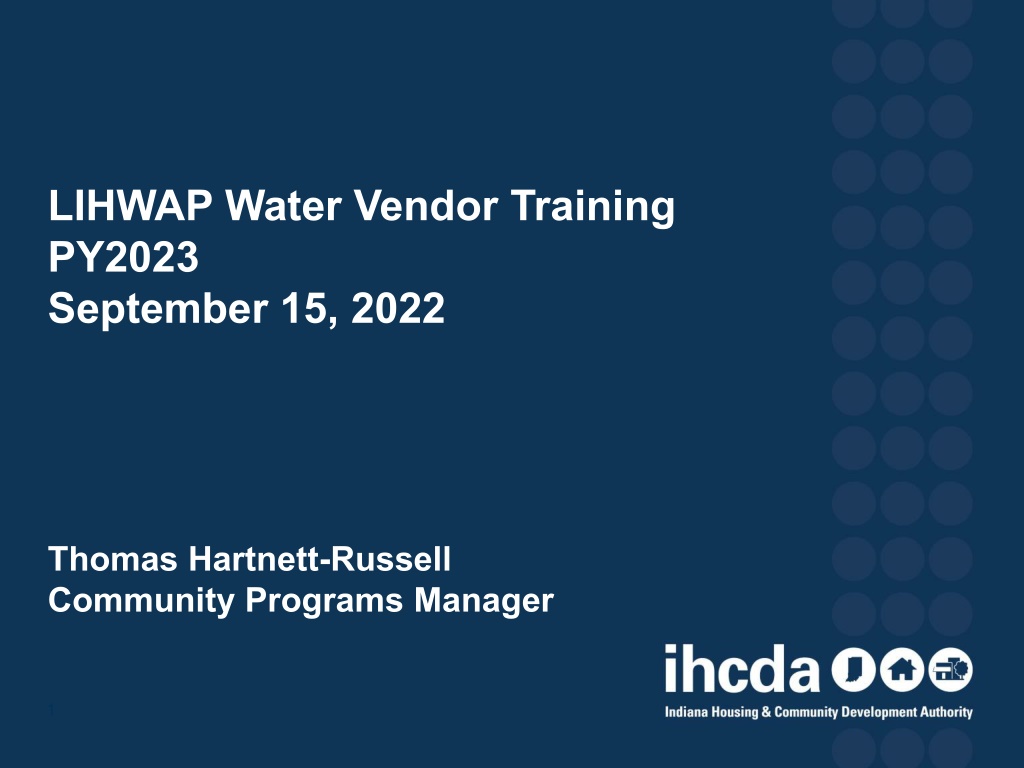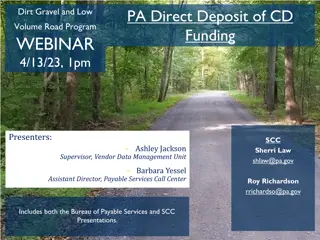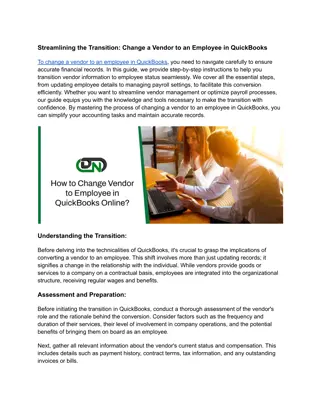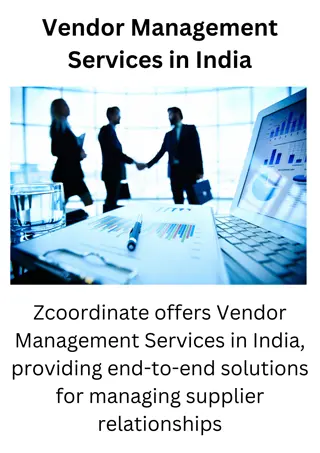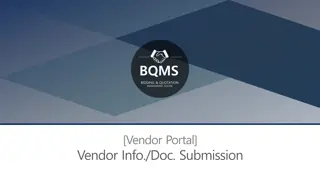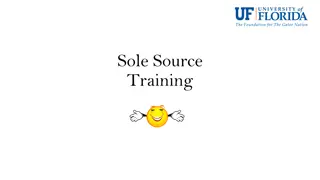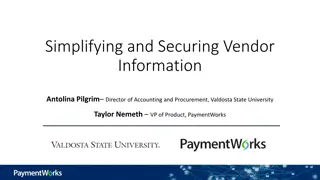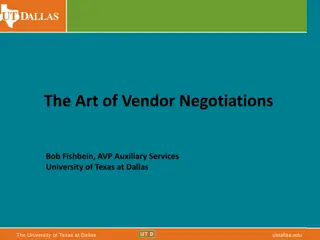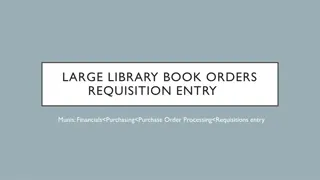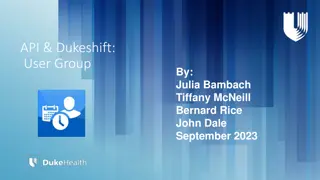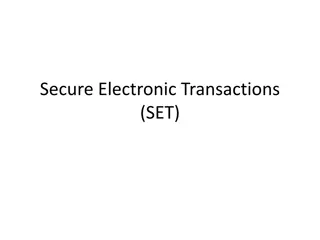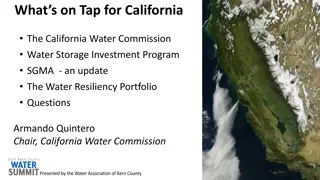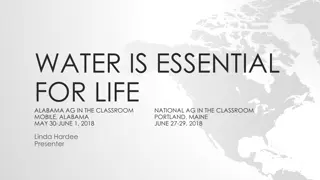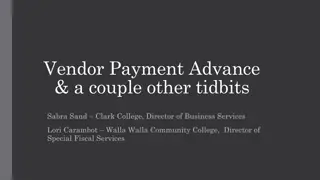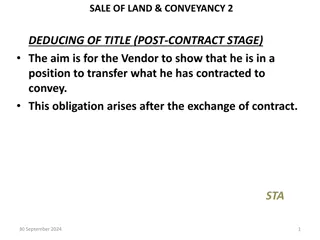LIHWAP Water Vendor Training Program Overview
This training program prepares vendors for the PY 2023 LIWAP season, focusing on common issues, collaboration, and improvement strategies. It covers the Water Program Overview, Vendor Guide, MOA, common issue areas, transmittal process, vendor monitoring, and contact protocols. The LIHWAP program assists low-income households with water and wastewater bills, offering temporary benefits without the requirement of disconnection or arrears. Indiana residents eligible for the Energy Assistance Program may also qualify for LIHWAP funding. Client eligibility is based on annual income and residency in Indiana.
Download Presentation

Please find below an Image/Link to download the presentation.
The content on the website is provided AS IS for your information and personal use only. It may not be sold, licensed, or shared on other websites without obtaining consent from the author. Download presentation by click this link. If you encounter any issues during the download, it is possible that the publisher has removed the file from their server.
E N D
Presentation Transcript
LIHWAP Water Vendor Training PY2023 September 15, 2022 Thomas Hartnett-Russell Community Programs Manager 1
PURPOSE OF THIS TRAINING The purpose of today s training is to prepare vendors for the PY 2023 LIWAP season by reviewing common issues and discussing ways to collaborate and improve for the upcoming season. Please note this is not a Vendor Portal Training Roeing will be responsible for that training and update. 2
TODAY WE WILL COVER Overview of Water Program, Vendor Guide, and MOA Common Areas of Issue Transmittal Process Vendor Monitoring Contact Protocols Next Steps 3
WATER PROGRAM OVERVIEW The Low-Income Household Water Assistance Program (LIHWAP) is a new program funded in part by the American Rescue Plan Act of 2021. LIHWAP is a temporary emergency program designed to help low-income households and families who have fallen behind on their water and wastewater bills. LIHWAP will provide income-eligible households with a one-time benefit to assist with current or past-due charges for water and/or wastewater services. Starting in PY2023, a household no longer needs to be disconnected or in arrears on these charges in order to qualify for a benefit. This funding is available to be used through September 30, 2023 and the program will be finished when the funds run out, unless additional legislation is passed to continue the program.
WATER ASSISTANCE Temporary program Can assist income-eligible households with current and past-due charges Cannot PURPOSEFULLY create a significant positive balance, but can assist with current charges as of date of application. Can pay deposits There is no in crisis distinction or required mitigating measures
APPLYING FOR THE WATER ASSISTANCE PROGRAM Indiana residents who qualify for the Energy Assistance Program (EAP) may be considered for LIHWAP funding as well. When completing the EAP application, applicants must check a box to apply for water assistance and submit their most recent bill. EAP accepts applications each year from October 1st until mid-May. Service Territory Map for EAP and LIWAP
CLIENT ELIGIBILITY LIHWAP benefits are available to households with a combined annual income at or below 60% of State Median income. In order to be eligible for LIHWAP benefits under this program, an applicant must maintain residency and active utility service within the state of Indiana. Documents Collected: Photo ID for head of household (person completing and submitting application on behalf of the household). Proof of US Citizenship or residency (Social Security card, Real ID, or other documents) Proof of Indiana Residency (utility bill, applicant s Driver s license, or other documents) Proof of Income for entire household Landlord Affidavit or Lease for applicants with utilities included in rent only Utility bills or account statements Other documents as needed based on specific household characteristics 7
BENEFIT DETERMINATION: THE BASICS Covers arrearages, deposits, reconnection fees, and current charges Cannot PURPOSEFULLY create positive significant forward balances Based on bill at time of application Crisis/arrearage benefit is based on exact amount on bill (minus any unallowable charges) An allowance is provided to help cover current charges All documentation the same as EAP Application Photo ID for applicant Proof of Indiana residency SSN verification for all household members Income documentation for all adult household members Water/wastewater bill Other documentation as required according to the circumstances
BENEFIT LEVEL Based on bill at time of application Both for arrearage and current bill No minimum Maximum of $2,500 (without a waiver) Are there any questions about the program?
VENDOR MOA Must be signed for client to receive benefit All benefits on behalf of clients are paid directly to Vendors Vendors must apply payments to the specific individual s account for water/wastewater Currently 212 Participating Vendors Includes consumer protections
ALLOWABLE CHARGES Water Wastewater Stormwater Fire Hydrant Flush Fees Fire Protection Hydrant Charge Disconnect/Reconnect Fees Taxes Deposits Costs associated with properties switching from septic tanks to local sewer system Cannot cover installment of the new lines or removal of old septic tank Can cover everything that happens after they are hooked up with the sewer company Sanitary Service Only if the vendor defines it as wastewater/dirty water
UNALLOWABLE CHARGES Trash Sanitation Solid Waste Extra Bin Street Maintenance Clean Air Fee Insurance Repairs Infrastructure Well Water Septic Benefits may not be assessed to settle an old debt on an inactive account unless settling this debt will lead to restoration of the account or establishment of new service for the customer. *We suggest to our LSPs that they check vendor website to clarify charges but if they cannot figure them out from the website they may reach out to your organization
CONSUMER PROTECTIONS 1) Application of Funds to the Household. The Vendor will apply funds provided by the Water Program to the household on behalf of which the funds were provided. The Vendor will then charge the eligible household, in the normal billing process, any difference between the actual amount due and the amount of the payment made by IHCDA. 2) Reconciliation. The Vendor will provide written reconciliation and confirmation to IHCDA upon request that benefits have been credited appropriately to households and their services have been restored on a timely basis or disconnection status has been removed if applicable. 3) No Adverse Treatment. No household receiving assistance under this grant will be treated adversely because of such assistance under applicable provisions of state, territorial or tribal law or public regulatory requirements. 4) Restoration of Service. The vendor must restore any disconnected services for an approved applicant within three (3) calendar days of receipt of payment from IHCDA on behalf of said applicant.
AGREEMENT #3: COOPERATION By signing the MOA, the vendor agrees to cooperate with IHCDA and LSPs with regards to sharing information about LIHWAP applicant accounts, including water consumption and cost, payments, disconnection prevention and restoration of service, arrearage amounts, account status, and other data related to LIHWAP. This includes but is not limited to providing billing statements for applicant households, regardless of the billing name of record. IHCDA has obtained consent from all applicants to collect this data. If the account is in the name of a non household member, the applicant has certified that they have obtained consent from the account holder. Collection of this data is federally mandated. 14
AGREEMENT #4: VENDOR RESPONSIBILITY FOR OTHER LOCATION(S) Only the parent company needs to complete an MOA and ACH form if the deposit and W-9 information for other locations match the parent. All subsidiary locations must be listed on MOA Attachment B if they handle their own transmittals. In order to streamline the management of vendors, we are seeking to reduce the number of distinct MOAs and ACH Authorizations where possible. In cases where payment goes to the same bank account, the locations should be grouped under the same parent organization for MOA purposes. If a specific person at a satellite/subsidiary office needs to be contacted for pledges or transmittals, that is an issue to be addressed with the Local Service Providers (LSPs) and does not impact the MOA. 15
AGREEMENT #12: ACCEPTANCE OF PAYMENT In accordance with state code, all payments must be made by electronic funds transfer (EFT). In order to be paid by check, the vendor must meet both of these conditions: The vendor does not have and is unable to establish a savings or checking account capable of receiving such payments with a financial institution within the business s geographic area without payment of a service fee. The vendor is able to provide a written statement from its financial institution confirming the inability to establish such an account without paying a fee. Claim approval and payment notifications will be sent via e-mail from reset@ihcda.in.gov. 16
AGREEMENTS #16: REFUNDS AND OVERPAYMENTS Refunds and overpayments are to be issued on separate checks. Refunds must be accompanied by: name of LSP client s name client s account number and transmittal number Overpayments must be accompanied by: overpayment remittance sheet the original transmittal number IHCDA has created a register sheet to accompany all refund/overpayment checks to assist our fiscal department in properly handling these payments. 17
AGREEMENT #20: RECORD KEEPING The vendor agrees to maintain an adequate accounting system to allow verification and auditing of the amount of service delivered to eligible households. This includes documentation that LIHWAP funds were not applied to unallowable costs and that refunds and overpayments were remitted to IHCDA rather than to the customer. Records must be maintained for a period of three years following the close of a program year (e.g., PY2023 records must be maintained until September 30, 2026). 18
MOA REQUIREMENTS Any questions on what we have just covered? Are there other areas where you have experienced issues in regards to the MOA? If the issue is super specific and may only apply to you we may table the conversation in training and work with you offline to resolve. 19
TRANSMITTAL PROCESS Transmittals will serve as the official record of the benefit for which a client has been approved. If there is a discrepancy between a pledge received via LSP contact and the amount on the transmittal, the transmittal amount will be considered correct. Transmittals are not valid for payment until they have been signed by both a representative of the LSP and a representative from the vendor. Any changes made to the transmittal need to be made prior to execution. All LSPs have been instructed to ensure that transmittals are generated and sent on at least a biweekly basis, with weekly transmittals strongly encouraged. 21
TRANSMITTAL PROCESS It is the vendor s responsibility to fully review the transmittal before signing it. This review should include: ensuring that the client is a customer of the utility; that the name, service address, and accountnumber are correct; and that the account is currently active and is not scheduled for disconnection or closure at the customer s request. If there are any errors or any accounts that need to be removed, it is the vendor s responsibility to mark these changes directly onto the transmittal report and adjust the total amount if necessary before signing and returning the transmittal report to the LSP. 22
TRANSMITTAL PROCESS Utility vendors should make every effort to return signed and/or corrected transmittals to the LSP within 7 days. If this will be delayed, we strongly recommend keeping an open line of communication with the LSP to inform them of the delay and when they may anticipate receiving the transmittal. Once an LSP has received a signed application back from the vendor, the LSP has 7 days to submit the transmittal to IHCDA for payment. Upon submission to IHCDA, payment should be generated within 30 days. Water utility providers are encouraged to note the benefit to the customer s account upon receipt of transmittal from the LSP. 23
TRANSMITTAL PROCESS If an LSP discovers an error has been made in benefit or eligibility determination, the LSP may award the client additional funds or submit a negative transmittal accompanied by an overpayment remittance. The LSP may award additional funds at any time. Overpayment remittances must be submitted within 60 days of initial approval. If an overpayment remittance is received more than 60 days following initial approval, you may inform the LSP that the window to request overpayment remittance has lapsed. In this case, it becomes the LSP s responsibility to repay the benefit out of unrestricted funds. You may choose to accept the overpayment remittance at your discretion even after the 60-day window has elapsed. 24
TRANSMITTAL PROCESS An overpayment occurs because: When a vendor receives a negative transmittal, they are to follow the same procedure as above. An applicant was accidentally awarded more funds than they were actually eligible for under the program rules or After returning the signed negative transmittal to the LSP, the vendor will also sign the overpayment remittance. they were approved for benefits when they were in fact not eligible. Therefore, any delinquency caused by the removal of an overpayment from the customer s account becomes the customer s responsibility to pay. The signed overpayment remittance is to be sent with a check to IHCDA and the returned payment register sheet to be reinvested in the program. 25
TRANSMITTAL PROCESS In order to keep payments on time and not negatively impact customers/clients, we are asking all vendors to return signed transmittals to LSPs within one week of receipt. Vendors must maintain records of all transmittal reports. Claim notification e-mails will note which transmittals have been approved for payment and the total of each transmittal. Please use these e-mails in conjunction with the transmittal reports for the purposes of correctly distributing funds and reconciling claims. Please remember that no LIHWAP funds are ever to be released back to the customer. All unused funds are to be sent back to IHCDA within 60 days of account closing along with the refund register sheet. 26
TRANSMITTAL PROCESS Discussion and questions What questions do you have? What issues have you experienced that you need additional support or guidance on? 27
VENDOR MONITORING AND BEST PRACTICES 28
WHAT IS VENDOR MONITORING? The purpose of vendor monitoring is to ensure compliance with the LIHWAP program by the utility vendor. It is also an opportunity to improve processes and lets us know where areas of confusion or additional assistance are needed Vendor monitoring is a federally-mandated component of the LIHWAP Statute as indicated on the MOA. All vendors that participate in the State of Indiana s LIHWAP are subject to vendor monitoring. Monitoring will be conducted as a desktop review. IHCDA is in the process of hiring an additional staff person to assist with Vendor communications and monitoring 29
VENDOR MONITORING PROCESS All vendors being monitored will receive an Assessment Completion Report within 30 days of IHCDA completing the desktop review. Vendors will be required to submit requested documentation prior to the start of the monitoring session. Vendors will be sent a 30-day letter notifying them of when the session is to begin. Vendors will be required to complete a Water Utility Supplier Survey. 30
VENDOR MONITORING DOCUMENTS Vendors will be required to complete a Water Utility Supplier Survey. A sampling of approved accounts found on a LIHWAP transmittal from the program year will be randomly chosen for review. All vendors are to comply with any request for additional information or documentation as a part of vendor monitoring as stated in the MOA. 31
VENDOR BEST PRACTICES All vendors should create written processes to promote consistency and program integrity. In turn those processes can be submitted at time of monitoring to show the utility s processes and program compliance. All vendors should perform internal quality assurance audits on LIHWAP customer accounts. All vendors should create a system to ensure that unallowable expenses are not being paid using LIHWAP funds. All vendors should create a three (3) year record retention and destruction policy for all LIHWAP documentation including electronic documentation. All vendors should strive to meet all reporting deadlines. This allows IHCDA to fulfill Federal Reporting requirements and make effective program changes. 32
VENDOR BEST PRACTICE Vendors should develop outreach strategies. Outreach is an important aspect of the Low Income Home Water Assistance Program. It helps fill in the gaps in services, so low-income households maintain access to residential water service. IHCDA is working with our Marketing Team on additional outreach material for this Program Year. https://www.in.gov/ihcda/program-partners/energy-assistance-program- eap/liheap-and-lihwap-resources/ - this link will house the new material once it is developed Please ensure you are providing clients with accurate information we have often seen links to the wrong websites. Correct link for sharing to connect portal: http://eap.ihcda.in.gov 33
CONTACT PROTOCOLS To help reduce confusion and streamline communication, you should ensure you are always communicating with the appropriate entity. In most cases, the LSP will be your primary point of contact. In some cases, IHCDA may be your primary point of contact. IHCDA is not the primary point of contact for clients/EAP recipients. No vendor or vendor representative should ever provide any IHCDA contact information directly to any customers, whether they are LIHWAP recipients or not. The next slide has additional information on common communications/ questions 35
WHO TO CONTACT LSP IHCDA Assistance for Clients http://in211.communityos.org http://eap.ihcda.in.gov Questions about a specific client/household Questions about payment that you are unable to answer after review of your transmittals and claim approval e-mails All referrals to LIHWAP from the http://in211.communityos.org http://eap.ihcda.in.gov vendors should be made to the appropriate LSP or 2-1-1. Questions about a benefit 2-1-1 or http://in211.communityos.org Questions about MOA terms Questions about submission of transmittal Problems getting information from LSPs Customers may be referred to http://eap.ihcda.in.gov for more detailed information or to apply online. Confirming application status Follow-up on a refund or Suspicion of fraud/misconduct at LSP level Notification of suspected customer meter tampering or unauthorized use when the customer is an LIHWAP client or applicant 36
LIHWAP/EAP SERVICE AREA 37
CONTACT PROTOCOLS To contact IHCDA, please use Water@ihcda.in.gov. This is a shared mailbox that the entire department can access. It ensures that your message can be read and addressed regardless of absences. You can cc Thom on the emails as well- THartnettRussell@ihcda.IN.gov Fiscal department is separate from LIHWAP and does not have access to this mailbox. What questions do you have? 38
NEXT STEPS This program year s calendar is: EAP ASSISTANCE SEASON October 1, 2022 Opening day of Federal PY2023. Online application opens to the public. LSPs may distribute mail-in applications to households who do not qualify as at-risk. Statewide start of the Energy Assistance Program: In-person appointments may begin. Transmittals may be sent to utility vendors. Applicant Notification letters may be sent to clients. End of EAP application period at 5:00pm Eastern time. All incomplete EAP applications must be fully processed. Last day to submit transmittals. All vendors must be fully reconciled. October 3, 2022 November 1, 2022 May 15, 2023 May 30, 2023 June 10, 2023 June 24, 2023 39
NEXT STEPS Thank you for attending this training and the hard work you complete to help make LIHWAP successful. If you have questions or concerns, please reach out to water@ihcda.in.gov IHCDA will be updating our Vendor Guide and the marketing material in preparation for the 2023 program year We are still working with Roeing to get a Vendor Portal Training scheduled. They are working through some enhancements for the 2023 year and once those are completed then they will be able to proceed with training 40
